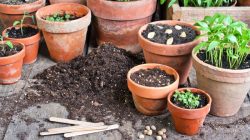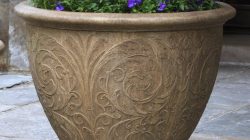Pot Plant Pot Materials and Styles

Pot plant pots for sale – The choice of pot for your cherished plants is a crucial decision, impacting not only their aesthetic appeal but also their health and longevity. The material and style of the pot directly influence water retention, drainage, and overall plant well-being. Understanding these factors will empower you to select the perfect vessel for your green companions.
Pot Plant Pot Materials
The material of a plant pot significantly affects its properties. Different materials offer unique advantages and disadvantages regarding durability, water retention, and aesthetic appeal.
We have a wide selection of pot plant pots for sale, catering to various plant sizes and styles. For those needing a larger capacity, consider our robust and reliable 5 gallon plant pot , perfect for established plants or those requiring ample growing space. Browse our complete range of pot plant pots for sale to find the ideal home for your greenery.
- Ceramic: Known for their elegant appearance and excellent drainage, ceramic pots are durable and long-lasting. However, they can be heavier than other options and are prone to breakage. Their porous nature can lead to quicker drying, requiring more frequent watering. A glazed ceramic pot will be less porous and retain moisture better. Imagine a sleek, white, cylindrical ceramic pot, perfectly showcasing a vibrant orchid.
- Plastic: Lightweight, inexpensive, and available in a vast array of colors and styles, plastic pots are a popular choice. Their durability is moderate; they are less prone to breakage than ceramic but can degrade over time with exposure to sunlight and extreme temperatures. Water retention varies greatly depending on the type of plastic. Picture a bright red, square plastic pot, ideal for a trailing pothos.
- Terracotta: These unglazed clay pots are highly porous, allowing for excellent aeration and drainage. This porosity, however, also means they dry out quickly, requiring diligent watering. Terracotta pots offer a rustic charm and are relatively inexpensive. Envision a classic, rounded terracotta pot, perfectly complementing a rosemary bush.
- Wood: Wooden planters offer a natural and elegant aesthetic, adding warmth and texture to any space. They are typically more expensive and require more maintenance to prevent rot and insect damage. Water retention varies greatly depending on the type of wood and its treatment. Visualize a sleek, dark-stained wooden planter box, housing a collection of succulents.
Pot Plant Pot Styles and Designs
The style of your plant pot can significantly impact the overall look of your space. From modern minimalism to rustic charm, the options are vast and varied.
- Modern: Clean lines, geometric shapes, and a minimalist aesthetic characterize modern pot styles. Think sleek, cylindrical pots in neutral colors or bold, geometric designs. Imagine a tall, slender, black ceramic pot, perfectly showcasing a fiddle-leaf fig.
- Rustic: Rustic styles evoke a sense of natural charm and warmth. These pots often feature textured surfaces, earthy tones, and natural materials like terracotta or wood. Picture a weathered, terracotta pot with a slightly uneven surface, housing a trailing ivy.
- Minimalist: Minimalist styles emphasize simplicity and functionality. These pots are often plain, unadorned, and in neutral colors, allowing the plant itself to be the focal point. Visualize a simple, white ceramic pot with a clean, cylindrical shape, showcasing a single, elegant orchid.
Examples of Pot Designs
Let’s visualize three distinct pot designs:
- Design 1: A large, spherical terracotta pot (diameter: 16 inches) with a slightly uneven surface, offering a rustic charm. Its porous nature makes it ideal for plants that prefer well-draining soil, such as succulents or cacti. The overall aesthetic impact is one of warmth and natural beauty.
- Design 2: A sleek, cylindrical ceramic pot (height: 12 inches, diameter: 6 inches) with a glossy, black finish. Its modern lines and sophisticated color make it perfect for showcasing a dramatic plant like a fiddle-leaf fig or a snake plant. The aesthetic impact is one of refined elegance and contemporary style.
- Design 3: A square, white plastic pot (10 inches x 10 inches x 10 inches) with a simple, unadorned design. Its minimalist aesthetic allows the plant to take center stage. Its lightweight nature makes it easy to move and re-arrange, suitable for smaller plants or herbs.
Pricing and Market Trends: Pot Plant Pots For Sale

The verdant world of potted plants, a vibrant tapestry woven from nature’s artistry and human ingenuity, presents a fascinating study in pricing and market dynamics. The cost of a potted plant, a seemingly simple transaction, is in fact a complex interplay of factors, reflecting both the intrinsic value of the plant itself and the artistry and materials invested in its presentation.The price of a potted plant is a delicate dance between several key players.
Plant size, a fundamental factor, directly influences cost. A petite succulent will naturally command a lower price than a majestic, mature fiddle-leaf fig. Rarity also plays a significant role; a unique or hard-to-find variety will fetch a premium compared to more common species. The material of the pot itself adds another layer to the pricing equation. Terracotta, ceramic, and hand-painted pots, each imbued with its own aesthetic charm, often reflect a higher price point than mass-produced plastic containers.
Finally, the brand recognition and reputation of the nursery or retailer can also subtly impact the final cost. Established brands, known for their quality and expertise, may charge more than smaller, lesser-known operations.
Factors Influencing Pot Plant Pricing
Plant size, species rarity, and the material and craftsmanship of the pot are key determinants. A small, common succulent in a simple plastic pot will be significantly cheaper than a large, rare orchid in an elaborately designed ceramic pot from a renowned horticulturalist. Consider, for instance, the difference in price between a standard-sized peace lily in a basic plastic pot versus a similarly sized peace lily planted in a hand-thrown, glazed ceramic pot.
The latter commands a higher price due to the added value of the artisan container. Brand reputation also plays a role; a well-established nursery known for its high-quality plants and expert care may justify higher prices than a smaller, less-known local grower.
Current Market Trends in Potted Plants
The current market for potted plants reveals a strong inclination towards specific styles and plant types. Biophilic design, emphasizing the integration of natural elements into indoor spaces, is a driving force. This trend fuels the popularity of larger, statement plants such as fiddle-leaf figs, monsteras, and snake plants. Color palettes lean towards earthy tones – muted greens, deep browns, and soft creams – mirroring a desire for calming, natural aesthetics.
The minimalist trend also persists, with sleek, geometric pots in neutral colors becoming increasingly popular. Sustainable and eco-friendly materials, such as recycled plastic or sustainably sourced wood, are also gaining traction, reflecting a growing consumer awareness of environmental concerns.
Price Comparison Across Retailers, Pot plant pots for sale
A comparative analysis of similar potted plants across various retailers reveals significant price variations. For example, a specific variety of snake plant might be priced at $25 at a big-box retailer, while the same plant, perhaps from a local nursery known for its superior plant care, could cost $40. These price differences can be attributed to factors such as sourcing, overhead costs, brand reputation, and the overall shopping experience.
Online marketplaces often offer competitive pricing, but shipping costs and potential damage during transit must be considered. Local nurseries, on the other hand, often provide personalized advice and superior after-sales service, which can justify a higher price point for some consumers.
Answers to Common Questions
What is the best pot material for succulents?
Terracotta pots are excellent for succulents because they are porous, allowing for better drainage and preventing overwatering, a common problem for these plants.
How often should I water my potted plants?
Watering frequency depends on the plant type, pot material, and environmental conditions. Generally, water when the top inch of soil feels dry. Avoid overwatering, which can lead to root rot.
What are some common signs of pest infestations in potted plants?
Look for small insects on leaves or stems, sticky residue (honeydew), discoloration, or wilting. Inspect regularly and address infestations promptly using appropriate insecticides or natural remedies.
Where can I find unusual or rare pot plants?
Specialty nurseries, online plant retailers, and botanical gardens often carry a wider selection of unusual plants. Check local plant societies or online forums for recommendations.










